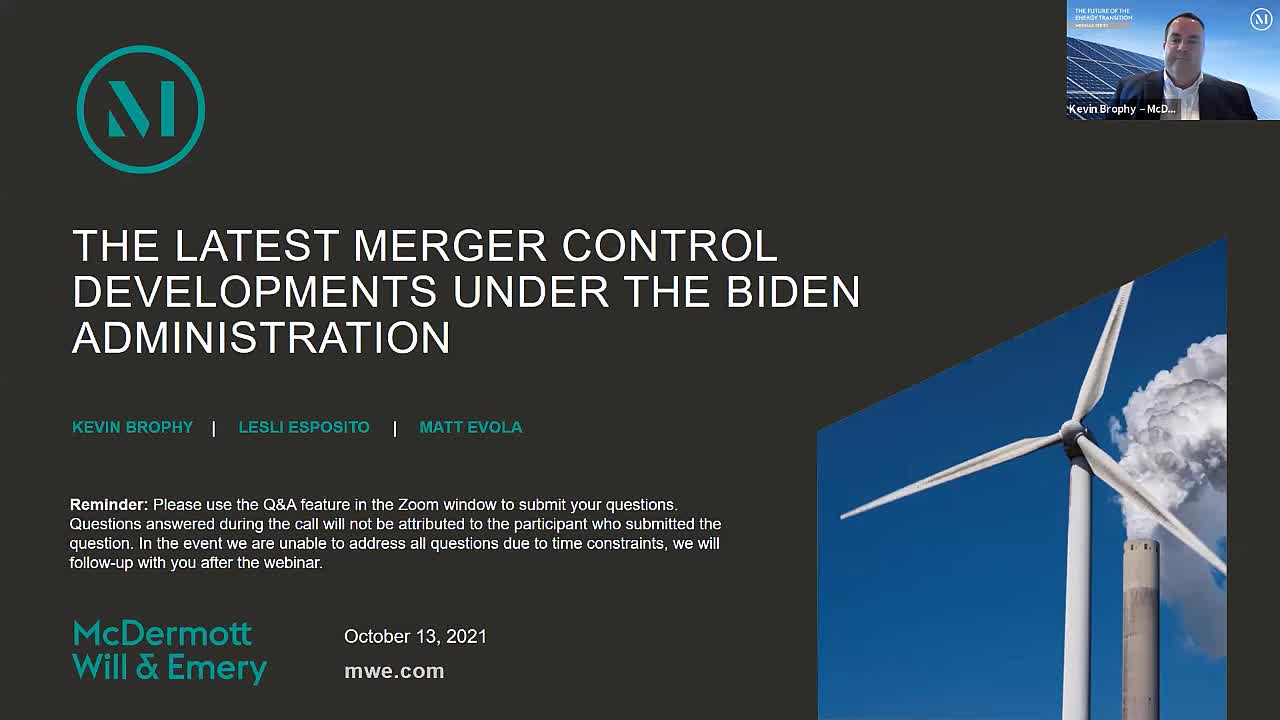The Biden administration has placed an emphasis on antitrust enforcement that will create meaningful implications for future transactions, as well as those already consummated. In this webinar, hosted by McDermott Will & Emery partners Kevin Brophy and Lesli Esposito and associate Matt Evola, learn who the new leaders at the Federal Trade Commission (FTC) and US Department of Justice (DOJ) Antitrust Division are and how their approach to antitrust enforcement is already changing merger review process.
 Below are key takeaways from the webinar: 1. Antitrust Agency Personnel Changes. The FTC and the DOJ Antitrust Division have recently seen leadership changes. At the FTC, US President Joe Biden appointed Lina Khan to chair, and she’s already making headlines for her efforts to “modernize” merger assessments. Chairwoman Khan has indicated that she wants the FTC to focus on addressing the “rampant consolidation” that has resulted in dominant firms across markets. She has also advocated for a holistic approach to identifying harms, a focus on power asymmetries and a need for the agency to be forward-looking. The changes she has implemented have significantly impacted merger review. At the DOJ, President Biden appointed Jonathan Kanter, who has not yet taken office but is also expected to take an aggressive approach to enforcement, to lead the Antitrust Division. 2. President Biden’s Executive Order on Antitrust. In a July executive order, President Biden indicated that antitrust enforcement would be a top priority for his administration. The order calls for a whole-of-government approach, encompassing 72 initiatives directed at more than 12 separate agencies. The order directed the FTC and the DOJ to vigorously enforce the antitrust laws by toughening the review of future mergers and revisiting anticompetitive mergers that went unchallenged. 3. Policy Changes with Practical Implications. The FTC has been especially active in announcing new policies and procedures that will likely extend the merger review timeline and open previously consummated transactions to further scrutiny. Among these changes are:
Below are key takeaways from the webinar: 1. Antitrust Agency Personnel Changes. The FTC and the DOJ Antitrust Division have recently seen leadership changes. At the FTC, US President Joe Biden appointed Lina Khan to chair, and she’s already making headlines for her efforts to “modernize” merger assessments. Chairwoman Khan has indicated that she wants the FTC to focus on addressing the “rampant consolidation” that has resulted in dominant firms across markets. She has also advocated for a holistic approach to identifying harms, a focus on power asymmetries and a need for the agency to be forward-looking. The changes she has implemented have significantly impacted merger review. At the DOJ, President Biden appointed Jonathan Kanter, who has not yet taken office but is also expected to take an aggressive approach to enforcement, to lead the Antitrust Division. 2. President Biden’s Executive Order on Antitrust. In a July executive order, President Biden indicated that antitrust enforcement would be a top priority for his administration. The order calls for a whole-of-government approach, encompassing 72 initiatives directed at more than 12 separate agencies. The order directed the FTC and the DOJ to vigorously enforce the antitrust laws by toughening the review of future mergers and revisiting anticompetitive mergers that went unchallenged. 3. Policy Changes with Practical Implications. The FTC has been especially active in announcing new policies and procedures that will likely extend the merger review timeline and open previously consummated transactions to further scrutiny. Among these changes are:
- The suspension of early termination for the 30-day Hart-Scott-Rodino Antitrust Improvements Act of 1976 (HSR Act) waiting period: Early termination has always been discretionary, but the FTC’s Premerger Notification Office has suspended early termination in 2021 with no resumption in sight.
- Warning letters sent at the conclusion of the HSR Act waiting period: These “close at your own risk” letters indicate that while the waiting period has concluded, the agencies may challenge the transaction post-closing.
- Increased requests for “pull-and-refiles”: This process restarts the HSR Act waiting period, granting agencies an additional 30 days to review a transaction, and are being requested at an increasing rate.
- Procedural and timing changes aligning the FTC with the DOJ: Changes made at the FTC are bringing the agencies into alignment on certain procedures for second requests, and these changes are likely to extend the timeline required for responding to second requests.
To access [...]
Continue Reading
read more

 Subscribe
Subscribe
